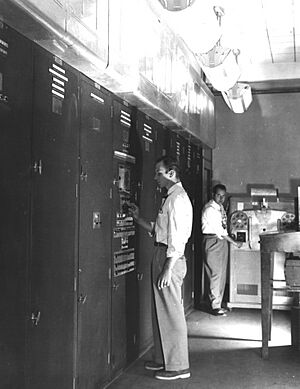EDVAC facts for kids
EDVAC (which stands for Electronic Discrete Variable Automatic Computer) was one of the very first electronic computers. It was built by the Moore School of Electrical Engineering in Pennsylvania. EDVAC was a follow-up to an earlier computer called ENIAC. Unlike ENIAC, EDVAC used a binary system (like 0s and 1s) instead of a decimal system. It was also designed to be a stored-program computer, meaning it could store its instructions inside its memory.
The inventors of ENIAC, John Mauchly and J. Presper Eckert, suggested building EDVAC in August 1944. A contract to build this new computer was signed in April 1946. EDVAC was delivered to the Ballistic Research Laboratory in 1949. This lab later became part of the US Army Research Laboratory in 1952.
Contents
Building a New Computer
Work on EDVAC began even before the ENIAC computer was fully finished. The goal was to make many important improvements to computer design. These improvements included a faster type of memory. Like ENIAC, EDVAC was built for the U.S. Army's Ballistics Research Laboratory by the University of Pennsylvania's Moore School of Electrical Engineering.
John von Neumann, a famous mathematician, helped with the design. He wrote a very important report in 1945 called First Draft of a Report on the EDVAC. This report talked about how computers could store their programs.
The first budget for EDVAC was $100,000. However, the final cost was almost $500,000, similar to the cost of ENIAC.
How EDVAC Worked
EDVAC was a binary computer. This means it used only two symbols (0 and 1) to do its calculations. It could automatically add, subtract, and multiply numbers. It could also divide numbers using a program.
The computer had a special type of memory called an ultrasonic serial memory. This memory could hold 1,024 "words" of data. In today's terms, this was about 5.6 kilobytes of memory.
Here are some of the main parts of EDVAC:
- A machine that could read and record information on magnetic tape.
- A control unit that managed the computer.
- A dispatcher unit that sent instructions to different parts of the computer.
- A calculation unit that did all the math.
- A timer to keep everything in sync.
- A memory unit made of mercury acoustic delay lines.
- Three temporary memory tanks.
EDVAC could add numbers in about 864 microseconds (which is very fast, about 1,160 operations per second!). It could multiply numbers in about 2,900 microseconds (about 340 operations per second).
Size and Power
EDVAC was a very large machine. It used 5,937 vacuum tubes and 12,000 diodes. It used a lot of electricity, about 56 kW of power. The computer took up 490 square feet (about 45.5 square meters) of floor space. It weighed about 17,300 pounds (almost 8 tons!).
It took a team of thirty people working in shifts to operate EDVAC.
Impact on Future Computers
John von Neumann's report on EDVAC was very important. It suggested the idea of storing the computer's program in the same memory as the data. This idea is now called the Von Neumann architecture. Most computers built since then have followed this design.
Some of the first computers to use this design were the EDSAC in Cambridge and the Manchester Baby in England. When a computer stores its program and data in different memories, it is called the Harvard architecture.
Using EDVAC
EDVAC was delivered in 1949. After some initial problems were fixed, the computer started working in 1951, though only for limited use.
By 1957, EDVAC was running for more than 20 hours a day. It could run without errors for about 8 hours at a time. EDVAC received several upgrades over the years. In 1954, it got punch-card input/output. In 1955, it got more memory using magnetic drums. In 1958, it got a unit that could do floating-point arithmetic, which is a way to handle very large or very small numbers.
EDVAC continued to operate until 1962. It was then replaced by a newer computer called BRLESC.
See also
 In Spanish: EDVAC para niños
In Spanish: EDVAC para niños


